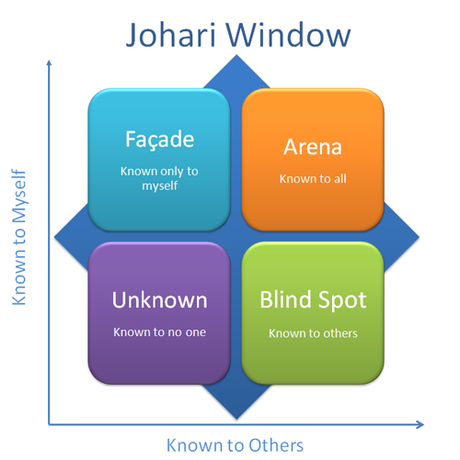
The Johari window was invented by two Americans in the 1950′s, Joseph Luff and Harry to explore relationships and interpersonal skills as part as an activity that gets a person to think fruitfully about something in order to come up with a solution.
The Johari window is a useful tool to use for managers who wants to improve their team management skills, but it must be managed with utmost care and attention.
This is not a great tool to use in a dysfunctional team – it is designed to help improve management skills and team cohesion and needs the goodwill that comes from voluntary participation for positive end results to transpire.
The Johari window is often used in the following contexts for a manager:
- Communication with themselves and with others
- Perception of their place in the workplace
- Presentation of themselves to their ownselves
- How they present themselves to others
The activity consists of the window, see below, made up of four quadrants :

- Room 1, “Arena” is the part of us that is known by ourselves and that others see.
- Room 2, “Blind Spot” is the part that is seen by others but not known by us.
- Room 3, “Façade” is known by ourselves but not seen by others
- Room 4, “Unknown” is the mystery section – unknown both by ourselves and not seen by others.
A list of 55 “standard” adjectives is given to the person receiving the feedback (the receiver), with the same list being given to their peers.
The receiver picks 6 or 7 that they feel describe themselves and their personality.
The peers do the same, then the adjectives are then mapped onto the window.Those adjectives that have been chosen by both the receiver and their peers are placed in the “Arena” quadrant as they illustrate character and personality traits which are known or recognised by both peers and receivers.
The adjectives that have been chosen by the receiver but not chosen by any of the peers is mapped onto the “Façade” quandrant as this illustrates the traits and character that are known by the receiver but unknown by their peers.
Adjectives that are selected by the peers but not by the receiver are mapped onto the “Blind Spot” quadrant as these are traits of character that are known or recognised by the peers but not by the receiver.
The remaining adjectives that have not been chosen by neither receiver nor peers are mapped onto the “Unknown’ segment as these are not recognised by either parties, or they are not relevant.
So, that was a nice clear activity to do ina team situation, but what happens next?I use this tool, with its advantages and drawbacks in various settings in coaching as a part of a diagnostics session prior to action planning.
Although the tool appears straightforward and simple to use in theory, it needs to be well-planned and executed rigorously.
After the facilitated diagnostics stage, this is where the coaching takes off, the session needs to be facilitated to explore some of the responses that were given and if needed in order to increase awareness, to work on team understanding and functioning or as a personal development tool that can help in various organisational settings, such as cross-cultural management where behaviour and reactions in professional work.
The tool is only as effective as the development plan or the learning plan that is then put into place to accompany the client through their process of growth, heightened awareness and learning.
Much like normal windows, The Johari Window has four sliding panels, which when slid across, will enlarge one window and reduce another – the objective being to reduce the unknown and blind spot quadrant whilst enlarging the Arena quadrant (in a perfect world) but this done through the awareness and development process.

